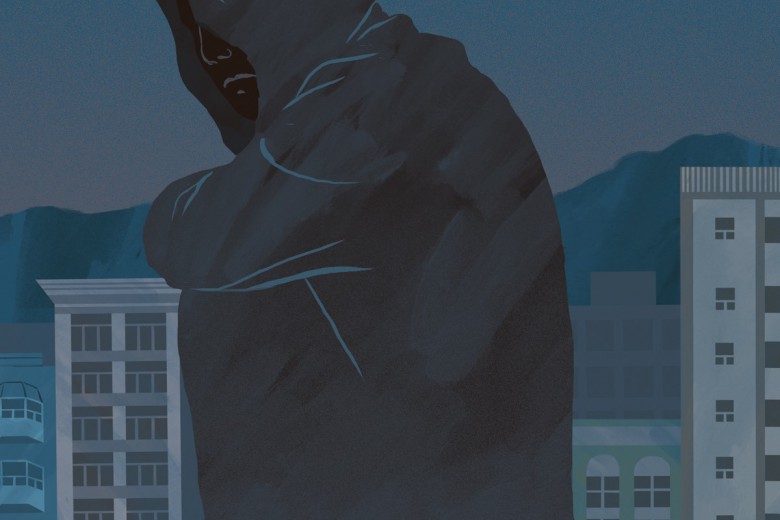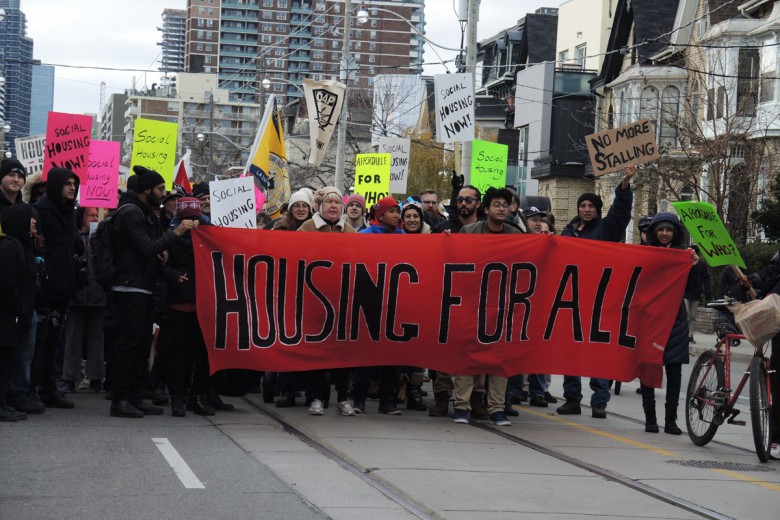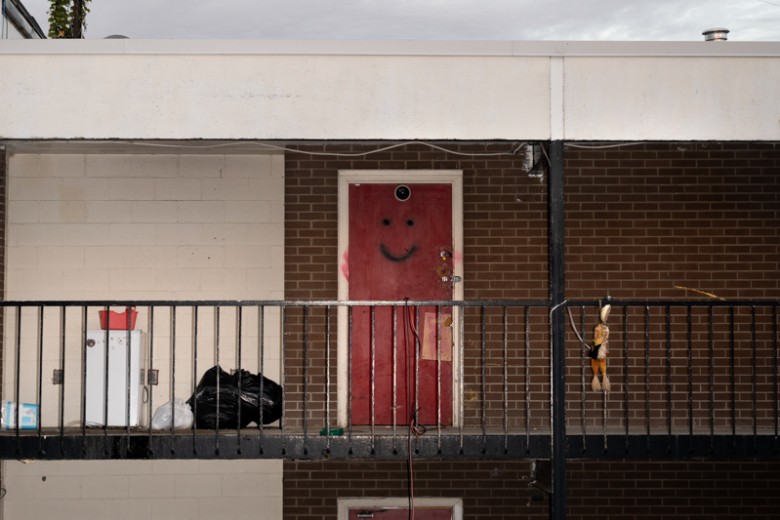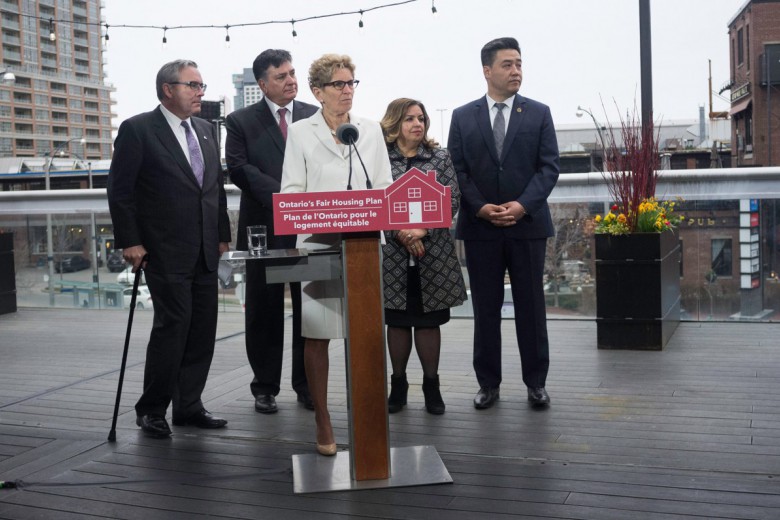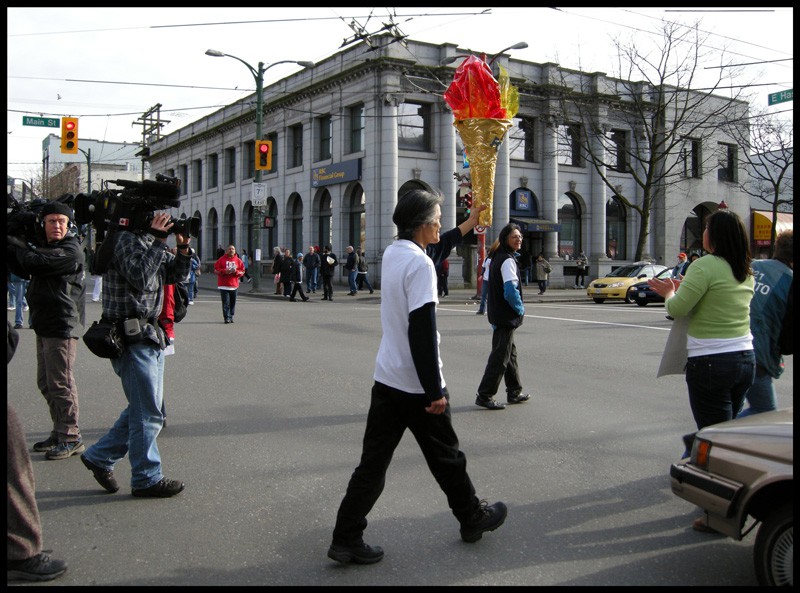
“I’m watching things speed up in my own city, Vancouver, as legislators tighten the noose around society’s most defenceless members. In the lead-up to 2010’s Olympic orgasm for developers, the city council has passed laws to keep street people from sitting on park benches or reclining in parks. Behind this crazy-making effort to create a “˜civil city’ is a conception of humans as rubbish.”_ -Geoff Olson, “The Future Isn’t What It Used To Be,” Common Ground, July 2007
“The law in its majesty prohibits rich and poor alike from sleeping under bridges.” —Anatole France
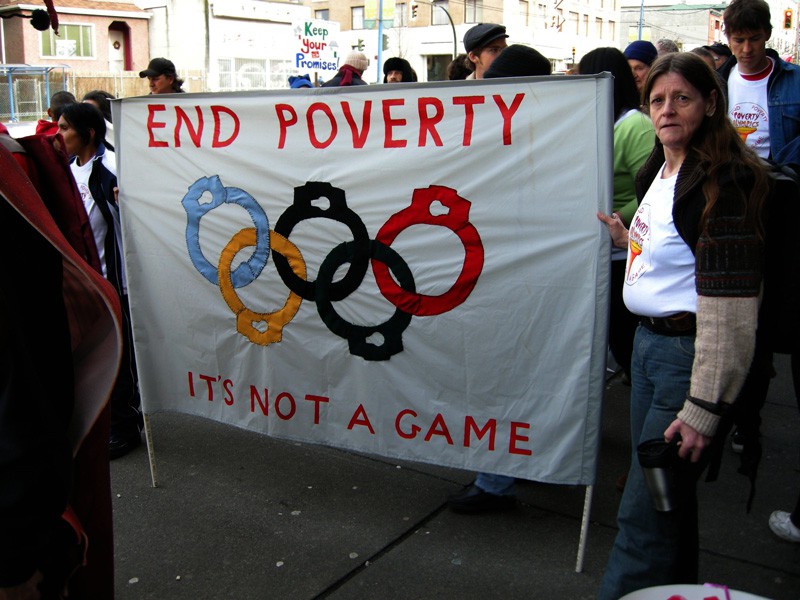
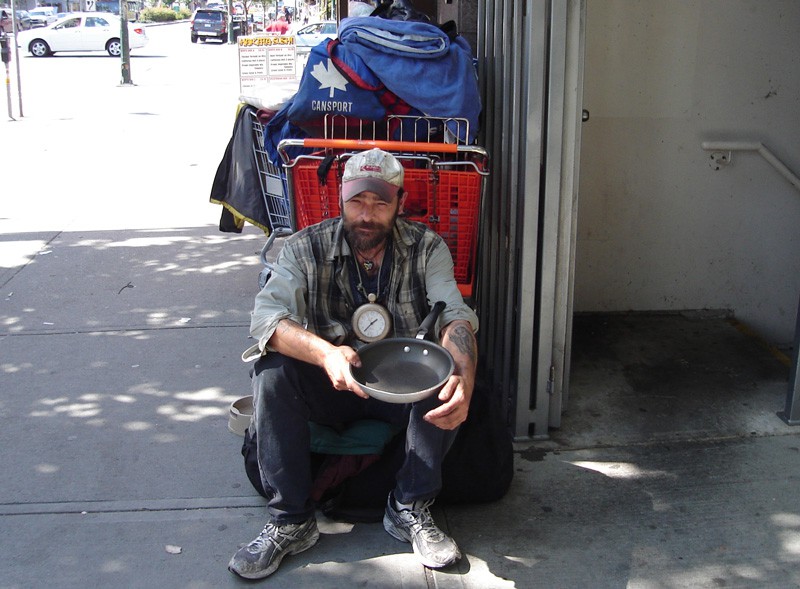
Home to legions of homeless people, drug dealers and users, sex trade workers and the working poor, Vancouver’s Downtown Eastside suffers levels of disease that are comparable to the worst found in the Third World and crime rates on persons and property that exceed all of the rest of Vancouver combined. A sense of defeat hovers over much of Hastings Street like a fog. But in defiance to circumstance, there is pride here, too, and community. It’s more than possible to imagine that the Downtown Eastside with its vibrant history would blossom in thousands of ways if only the various levels of government cared enough to help. That government doesn’t care speaks volumes to social priorities in Vancouver’s headlong rush to be a “world-class” city, and nowhere is this more obvious than in the handling of the Downtown Eastside and its inhabitants in the lead-up to the 2010 Olympics.
Those who only drive through the Downtown Eastside en route to somewhere else tend to see only the long lines at the soup kitchens, the addicts congregating in alley ways, the hookers on their stroll and the homeless sleeping on benches and in doorways. Some, though, don’t see Third World misery, but rather opportunity and a brighter future-for themselves, the developers. Instead of a vast urban wasteland filled with the homeless lining up for food, they see a queue of yuppies ready to live on the edge, buying upscale $500,000 one-bedroom condos overlooking the squalor in the streets below.
All these developers needed to make their dreams a reality was a spark to light the fire that would drive out the rabble. The eternal flame of Mount Olympus served the purpose quite nicely. In 2003, the spark caught and dreams became reality: the Olympic machine was coming to town, and with it, the power to gentrify the Downtown Eastside.
“All the developers needed to make their dreams a reality was a spark to light the fire that would drive out the rabble. The eternal flame of Mount Olympus served their purpose quite nicely.”
Closures, evictions, and other forms of “economic cleansing”
Before the 2010 Games were Vancouver’s, the bedbug-ridden hotels in the Downtown Eastside were fairly strictly policed; city inspectors routinely cited the owners for safety and hygiene violations. To avoid fines, the owners had to comply with what were really the most minimal of regulations. After the 2005 civic election, with the pro-Olympics Non-Partisan Association triumphant, the city’s attitude abruptly seemed to change. Now, rather than fine the owners, the city began closing the offending hotels.
Often, with only hours’ notice, residents were dumped onto the streets to join the thousands of others who wander the alleys by day and sleep on the sidewalk by night. Anti-poverty groups such as the Pivot Legal Society, the Anti-Poverty Committee and the Downtown Eastside Residents Association say a number of hotels have closed in this manner, adding many more people to the legions of the homeless. According to David Eby of the Pivot Legal Society, a total of 1,314 rooms that formerly housed low-income individuals have been closed or converted to other uses since the awarding of the Games to Vancouver in 2003.
*These figures are drawn from the Regional Steering Committee on Homelessness’ triennial homelessness count, and are widely acknowledged, even by count organizers, to underrepresent the true extent of homelessness in Vancouver.
Michelle Patterson, a researcher and adjunct professor at SFU’s faculty of health sciences and a volunteer in the count, estimated in an April 2008 Georgia Strait article that the actual number of homeless people in Vancouver was closer to 8,000, far higher than the official figure of 2,592. (Infographic: Rose Zgodzinski)
The city claims that the hotel closures are the simple result of enforcing bylaws for the safety of the residents of the closed hotels, but the Pivot Legal Society, the Anti-Poverty Committee and the Downtown Eastside Residents Association have a more likely explanation: the city is helping landlords close the hotels deliberately because they want to flip the property so that it can be sold to developers. The developers, in turn, plan to tear the old buildings down and put up hotels to fill with Olympic tourists in 2010. After the Games have gone, the upscale hotels will be converted to condos for the urban upwardly mobile, and many believe Vancouver will see more of the urban gentrification that accompanied the city’s fabled Expo ’86.
“Economic cleansing” is the ticket, and Mayor Sam Sullivan has the plan. If the Downtown Eastside is ugly and drug infested, he can sweep it all away courtesy of Project Civil City, Sullivan’s less than subtle manoeuvre to rid Vancouver of the relics of years of institutional neglect. Or maybe the city could ship the homeless out to other parts of the province “for treatment,” as the province’s Liberal Forests Minister recently suggested, the idea eerily reminiscent of the wholesale urban clearances of the poor in the run-up to Atlanta’s Olympics in 1996. The statement seemed likely to be a trial balloon, sent up to gauge public reaction.
Mayor Sullivan, the Non-Partisan Association, the provincial government and their real estate developer backers can see a new Kitsilano (an upper-middle-class enclave that was once dominated by artists and activists) arising out of the drug dens of the Eastside. Did the Olympics and the Vancouver Organizing Committee for the 2010 Olympic and Paralympic Winter Games (VANOC) do this? Not directly, but those involved knew it would come to pass. Indeed, the Vancouver 2010 Bid Corporation knew, too, even as it and the city made their empty promises that no one would get left out of the Olympic legacies. The promise of “inclusivity” was not really meant for the city’s poorest and most vulnerable.
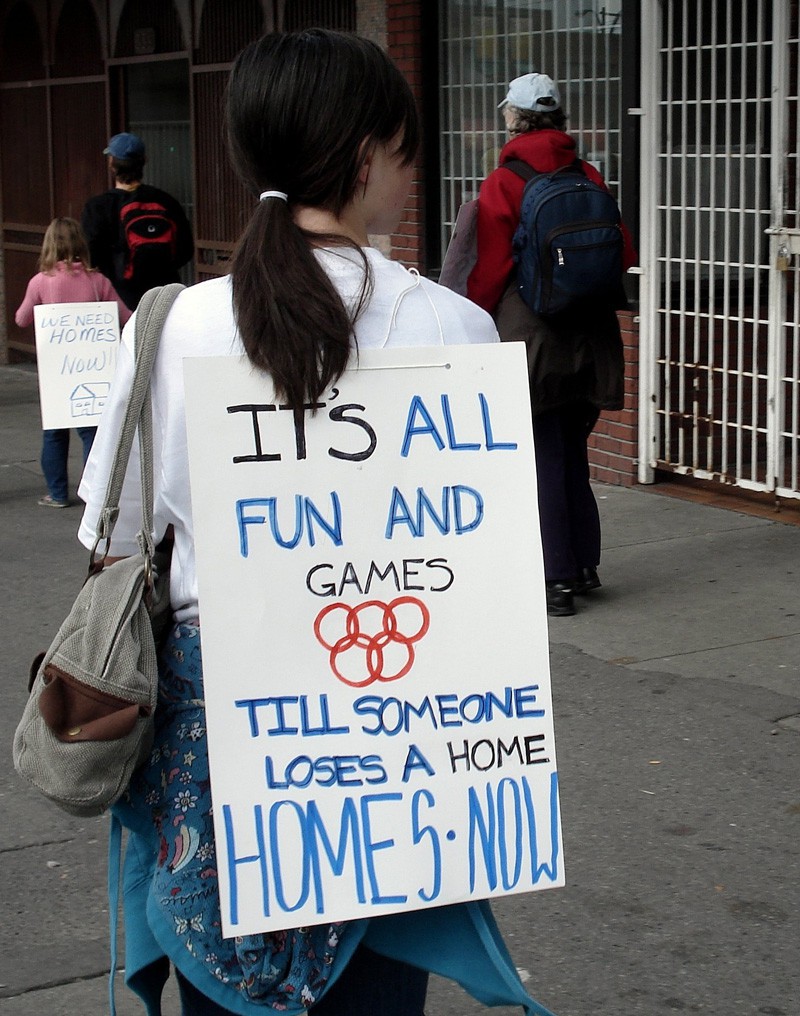
Vancouver’s red zone
Cameron Bishop lives on the street near the center of the Broadway corridor, a corridor that runs east to west across the city. Bishop is in his early 40s, slim, bearded, with a ball cap covering longish receding hair. He’s been on Vancouver’s harsh downtown streets for over a decade, pretty much from the time he came out of the Canadian Army where he served in the infantry.
Bishop knows guns; he’s certainly seen his share of them in his life, many recently. Vancouver police officers have taken to placing their revolvers up against his head at night while he lies sleeping on the ground. During one such incident, the officer told him: “It’s the Olympics or you, and it ain’t you, so you’d better move on.”
Bishop has been threatened with beatings and worse if he stays in the area, threats that suddenly became reality when he was set upon by unknown assailants and severely mauled. He’s also been handed court summonses for loitering, for begging, for whatever the police want to charge him with. One officer told him that he was banned from the entire Broadway corridor, “red zoned.” He faces fines that he cannot possibly pay, or jail time, if he doesn’t move on. But move to where? Like the homeless across the city, Bishop has his own local community of fellow homeless. He is also afraid of the far more hostile streets of the Downtown Eastside.
The area where Bishop lives didn’t have a homelessness problem before the 1990s. The Fairview district of the city has historically been an upscale district with high-end condos and restaurants, all within a long stone’s throw of Vancouver’s City Hall and General Hospital. The urban poor and the homeless then were across False Creek, pretty much segregated in the Downtown Eastside. This all changed in the 1990s as government cutbacks spilled hundreds, then thousands, more onto the streets across the city.
No one knows how many of the homeless live in and around Fairview, but the scale of the problem can well be estimated from the dozen or more who congregate in the few short blocks between City Hall and the hospital. And it’s not just in Fairview, but in districts across Vancouver, even in the surrounding municipalities. Poverty in the Lower Mainland didn’t originate with the Olympics, but there was a remarkable coincidence in the extent of it. As cited above, the rate of change makes it difficult not to conclude that there was some sort of cause-and-effect relationship.
Red-zoning, itself, was definitely a by-product of the Olympics coming to Vancouver, as were the various punitive pieces of provincial and municipal legislation. Such legislation serves to highlight the utter failure of the different levels of government to actually address the gnawing poverty that affects so many. In the process, it demonstrates to anyone with an ounce of social conscience the chasm between a world in which the Olympics are the party of a lifetime and another, harsher world, where the Games are yet another kick in the teeth to those already battered to their knees.
The implications of red-zoning for civil liberties are not trivial either, not for the homeless, not for Olympic opponents, ultimately not for anyone.
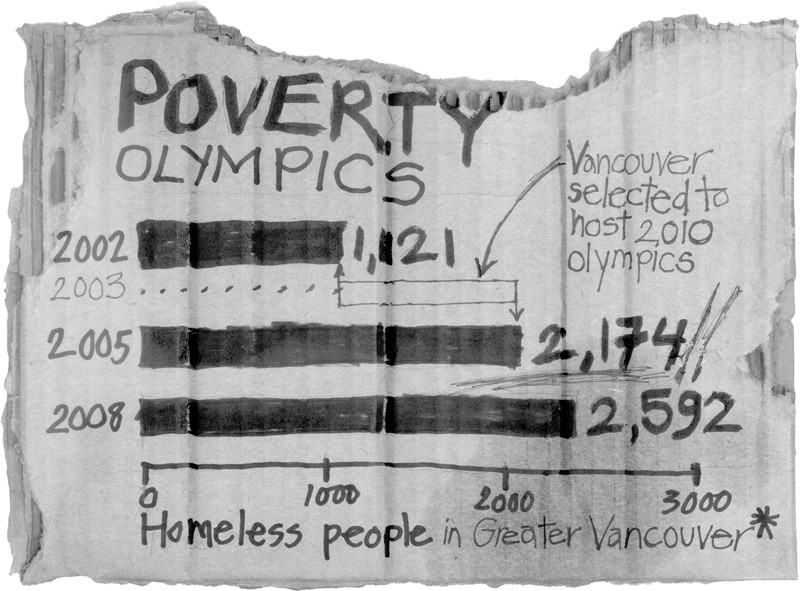
Criminalizing poverty
Sam Sullivan came back from his Torino flag-waving adventure of 2006 determined to “clean up” the city before 2010. He could have actually chosen to keep promises to the poor and provide the 3,200 housing units that would end the current wave of homelessness in the city. Instead, he and the Non-Partisan Association decided to legislate the problem away. Thus was born Project Civil City, Sullivan’s path to ending the poverty problem by making its victims criminals and treating them as such.
The city’s Project Civil City, as launched in 2006, set four main targets to be achieved by 2010. First, it aimed to eliminate homelessness, with at least a 50 per cent reduction-the “how” not specified, and at absolute variance with the lack of funding for the housing that would be required to meet this goal. Second, the plan called for eliminating the open drug market with at least a 50 per cent reduction. How? More cops, obviously. Third, Civil City planned to eliminate the incidence of “aggressive panhandling” by 50 per cent.
Reducing panhandling so as not to inconvenience rich Olympic tourists was nothing new; in fact, several years earlier provincial legislation, notably the “Safe Streets” Act, saved the good citizens of the province from “aggressive squeegee kids.” Finally, Civil City called for a 50 per cent increase in “the level of public satisfaction” with the city’s handling of public nuisance and annoyance complaints. What this meant seemed very open to interpretation, but at the least, it suggested that the “public” in question was more the Vancouver Board of Trade type than average citizens, the latter including many who wanted real solutions that actually helped rather than punished the poor.
Overall, there were some 54 sub-recommendations, 10 of which Sullivan wanted undertaken immediately by city council, while a more comprehensive implementation plan was being activated.
These recommendations included introducing “dumpster-free alleys,” or, in other words, take away one of the few sources of income for homeless people by removing their access to recyclable bottles and cans, again a proposal that had previously surfaced in other Olympic host cities. The city also proposed to “conduct a public awareness campaign on the negative impacts of providing money to panhandlers,” just to ensure that they really had no possible source of income short of crime.
There were multiple recommendations about more police, police auxiliaries, bylaw enforcement officers, prosecutors and the presence of security cameras everywhere, the latter earning a pointed comment from civil liberties groups calling the recommendation “a serious erosion of a citizen’s right to appear in public spaces without being monitored.” There was also a raft of proposals for a Community Court, ticketing and fines, etc. And, amongst all the punitive measures, the city proposed to “conduct a study of our homeless population.” Hence, first penalize those you’ve put on the streets, then figure out why they are there, as if you don’t already know.
And all under the banner of the five colored rings, supposedly the symbol of peace and brotherhood.
Olympic promises: Just more carbon emissions
The empty promises of the Bid Corp and the City of Vancouver seemed, for many, to guarantee that the Olympic Games would be for everyone. Although the environment didn’t really score a promise as such, Vancouver’s poor and homeless sure did. But, just as surely as Vancouver’s temperamental weather can shift from brilliant sunshine in an azure sky to torrential downpours 15 minutes later, so too, the promise to the poor began to dissipate. What had been an officially unbreakable “promise” in the bid period became a “commitment” post-bid, drifting to a “goal,” then a “hope,” before being finally abandoned altogether.
Even late in the process, VANOC’s sub-boss John Furlong had said: “Our housing commitments are quite specific. They fall into three categories. We have committed $30 million to the direction of the village in Vancouver, with that commitment we will of course be assured of 250 units of housing that fall into the category of non-market social housing.”
Alas, the City of Vancouver was soon to bail on the 250 units, the number dropping by 90 per cent not long after Furlong’s words were spoken. According to a report prepared by city staff for Vancouver’s City Council, “It’s not clear whether any more than 10 per cent of the 250 units of social housing at the site can be reserved for the poor.” Then even that minimal guarantee was dropped.
The same report noted that of the 3,200 units promised overall, it was “questionable” if the units could be built by 2010. In fact, it was clear that if construction of the units didn’t start by a drop-dead date of October 2007, it simply couldn’t happen by 2010 at all. The drop-dead date came and went with no start on construction.
All in all, the report suggested that a total of 25 recommendations made by various stakeholders in the so-called Inner City Inclusiveness Tables were not going to be met. There had never been any real plan to do so. The exercise from the onset had not really been to “include” the poor, it had been to hoodwink the public with the idea that they would.
All that anti-poverty advocates could do was complain and try to raise the issue at the international level. While such publicity might have been embarrassing for Vancouver, nothing changed in the realities on the streets.
Resistance and hope
By 2006 it had become obvious to the various anti-poverty groups in Vancouver that not only were poverty and homelessness increasing, but the City of Vancouver was not going to do anything about it. The most radical of these groups, the Anti-Poverty Committee, staged a series of protests and actions that served to make government and VANOC nervous. Each time VANOC would hold a special event, the Anti-Poverty Committee was there. At the unveiling of VANOC’s “Olympic clock,” one activist grabbed the microphone and shouted obscenities against the Olympics. Native activists drummed and sang in protest, drowning out the songs of the natives that VANOC had brought out for the event.
The Anti-Poverty Committee began to get media coverage, and while the latter tended to be very negative, the genie was out of the bottle; many British Columbians were forced to face the fact that poverty in Vancouver had increased as a consequence of the 2010 Olympic developments. The city struck back: Anti-Poverty Committee members were arrested and charged, and another anti-poverty group allied to them, the Downtown Eastside Residents Association, had their city funding cut off.
Vancouver City Council had dug in its heels, and Mayor Sullivan declared that the city was not going to “surrender to hooligans.” They weren’t going to do anything serious about the underlying poverty issues either. The promises to the poor, promises that had led many social progressives to vote yes in the plebiscite, were simply abandoned. Although many Vancouverites noted the broken promises, a large number didn’t really seemed to care, at least if the mainstream media were to be believed. In this regard, Vancouver mimicked Sydney where, “Sydney Olympic organizers relied on “˜Olympic spirit’ discourse to diffuse public outrage on the numerous occasions when Olympic officials failed to live up to the lofty standards touted in pseudo-religious rhetoric.”
And just in case anyone in the Anti-Poverty Committee or any other organization had thoughts of doing anything even more radical, the Olympic security machine was beginning to sputter to life. As we will see, the 2010 security forces might not be able to do much against a real external threat, but perhaps that wasn’t to be their main purpose: Maybe their raison d‘être would be to contain domestic Olympic opponents.
Christopher A. Shaw is a professor of Ophthalmology at the University of British Columbia, the lead spokesperson for 2010 Watch, and a policy and media analyst for the Work Less Party. This article is excerpted from Shaw’s book Five Ring Circus: Myths and Realities of the Olympic Games, published this year by New Society Publishers.


